
This article has two parts. In the first part we see depictions of the stories told about the early days of mortals, namely (Prometheus, Pandora and the Flood).
Part 1
In the second part we take a look at the principal family of major gods and goddesses, known as the Olympians (after their home, Mount Olympus), beginning, of course, with the supreme god Zeus, as well as Olympian queen Hera and the sea god, Poseidon.
Part 2
In the article on The Titans, Hesiod's Theogony was the primary source for the Greek story of creation and the rise to power of Zeus. This same poem also contains the story of Prometheus, son of a Titan, sometimes credited with the creation of the first people, as depicted below in the painting by Piero di Cosimo from about 1500. The artist has used a multiple-image technique to compress different parts of the story in one painting: the main scene shows Prometheus crafting the first human from clay, guided by Athena (right of center) and these two appear again in the sky, with Prometheus stealing fire, as seen in other images below.

Piero di Cosimo
During the first-ever animal sacrifice, mortal men were expected to give over the best parts of the animal to the gods, while they could keep whatever was left over. Prometheus attempted to use a deception on Zeus in order to gain the better parts for the mortals, but Zeus caught on to the trick and punished mankind by taking away the gift of fire.
Still trying to help the humans, Prometheus disobeyed Zeus and stole it back and returned it to the mortals. This deed is seen below, first in a Roman sarcophagus relief, set at the workshop of the blacksmith-god Hephaestus, where Prometheus arrives (far right) to steal away one burning coal.

Roman Sarcophagus Relief
Next is the painting by 17th Century artist Jan Cossiers (1600-1671), showing Prometheus descending from heaven with fire.

Jan Cossiers
Finally there is the Art Deco sculpture, a 20th Century work by sculptor Paul Manship (1885-1966), now a central New York City landmark at Rockefeller Center.

Paul Manship
Upon discovering Prometheus' crime, the enraged Zeus decreed a special punishment for Prometheus, just as he had previously condemned Atlas, the brother of Prometheus, for siding with the Titans in the battle of Zeus and Cronus.
In the first view, we see a black-figure vase painting from Sparta, dated to about 555 B.C., showing the punishments of both brothers: Atlas on the left supports the dome of the sky, while Prometheus, bound to a stake, has his liver torn out and eaten (daily) by the eagle sent by Zeus. The artist's name is unknown, but his work is known from more than one object, and so art historians create a name for this individual, usually based on some subject they painted. In this case, the artist is named for another vase painting (not pictured) which depicted a historical king named Arcesilas; hence the pseudonuym "Arcesilas Painter".

Arcesilas Painter
The next painting was in fact a collaboration between two prominent Baroque artists, Peter Paul Rubens (1577-1640) and Frans Snyders (1579-1657), dated to 1611-12. Rubens was highly regarded for his skill dramatically depicting the human body, in any pose whatsoever, while Snyders was known for his talent painting animals, especially birds. Their skills certainly blended well in this vivid version.

Rubens-Snyders
In contrast, the version by Gustave Moreau (1826-1896) is serene. The gory punishment is indicated by the presence of the bird (notice that Moreau has used a vulture instead of the traditional eagle), but Prometheus himself is at peace with it, calmly accepting his fate. There is no doubt that Moreau has based Prometheus' facial features on the style used to portray Christ in artwork of the Renaissance. Also interesting is the little flickering flame of inspiration hovering above his head.

Gustave Moreau
Next are a few images of Atlas alone. The first is a Roman-era sculpture clearly depicting the globe of the heavens (not the earth) on his shoulders.

Roman Sculpture
Then a 20th Century metal sculpture by artist Lee Lawrie (1877-1963), a modernist figure of Atlas, companion to the Prometheus at Rockefeller Center in New York.

Lee Lawrie
The sculpture was featured on this 2001 postage stamp—a stamp used only for presorted bulk mail, or as we usually refer to it, junk mail.
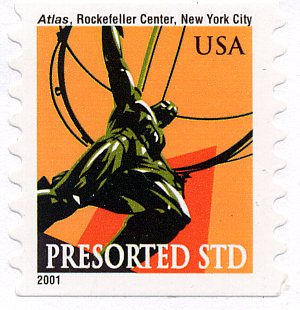
Stamp
We turn to the poet Hesiod for the next part of the story. In fact, Hesiod tells the story in two separate poems, the Theogony and the Works and Days. In each version he repeats the basic elements of the story, that Zeus ordered the creation of the first woman as a way to punish mankind (literally, all mankind in this story) for their role in the deceptions of Prometheus. He had the god Hephaestus fashion her body from clay, while the other gods each contributed a portion to her as well, explaining her name: Pan (all) + dora (gifts).
This is seen twice here, first in a badly damaged white-ground vase painting from the classical period. (This is another vase painting style which became somewhat popular in the 5th Century B.C., when most vase paintings were red-figure. The White Ground technique gets its name from the white background used to 'prime' the surface and provide a blank background on which they could apply color a bit more freely.) This example shows Athena and Hephaestus working on Pandora in the middle (see the accompanying facsimile drawing which fills in the gaps).

White-ground
The red-figure version includes several other gods: on the left of Pandora are Ares and Hermes, on her right are Aphrodite, Poseidon and Zeus.

Red Figure
The other part of the story of Pandora is what she did after being given to Epimetheus, another brother of Prometheus. Epimetheus was slow-witted, and unable to foresee how much trouble she would cause. Pandora opened a forbidden container (usually called Pandora's Box, although in ancient Greece, the container was described as more of a jar or vase with a lid). Inside this box were all the troubles of the world: old age, disease, hard work, etc. In the story, because of Pandora, humanity is forever cursed by trouble-making women and the evils she released (a highly male chauvinistic view, obviously).
We see this part of the story by two artists who were contemporaries, and both members of a movement within mid-19th Century Romanticism known as the Pre-Raphaelites. Dante Gabriel Rossetti (1826-1882) was one of the founders of this movement, and the artist of this painting of Pandora, while J. W. Waterhouse (1849-1917), another British Pre-Raphaelite, produced the second painting.

Pandora - Rossetti (1871)
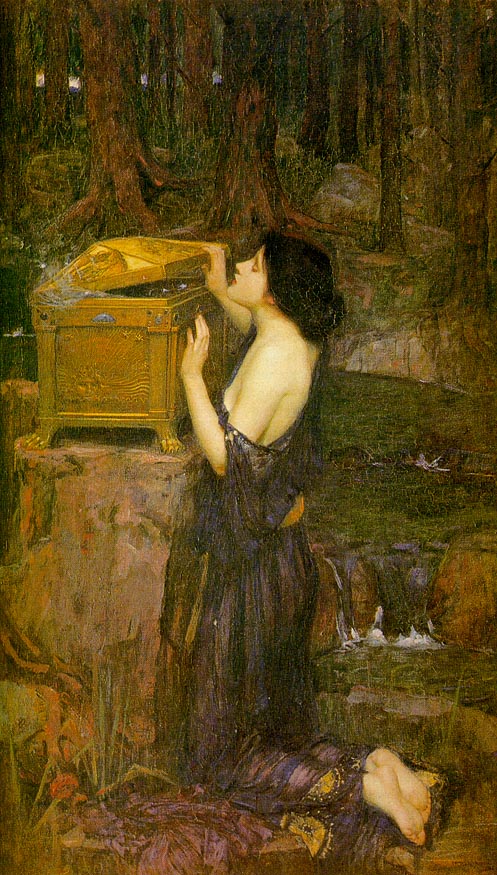
Pandora - Waterhouse (1898)
Another important story set in the early days of mortals is the Great Flood. (This is of course parallel to the Biblical story of Noah and the Flood in the Book of Genesis.) In the Greek version, Zeus had determined that humanity was essentially wicked and he would flood the world and start afresh. One couple, however, was chosen to ride out the flood and when it was over they would help to repopulate the world. Their names were Deucalion, son of Prometheus, and his wife Pyrrha. After the floodwaters receded, they consulted a sacred oracle to ask what they should do next. The oracle instructed them to "throw the bones of their mother" over their shoulders. Deucalion realized that what the oracle really meant was rocks, for these are the 'bones' of mother earth. As they did this, the rocks they threw were born as a new race of people.
We see the story depicted in a sculpted version by American artist Lorado Taft (1860-1936), who lived and worked in the city of Chicago in the early 1900s. Taft produced many beautiful public sculptures still visible in Chicago, but the first image here depicts a project which was never completed, the Fountain of Creation.

Fountain of Creation, Lorado Taft (1918)
Around 1917, Taft proposed to the city a pair of huge fountains, one at each end of a strip of public park known as the Midway Plaisance on the south side (very close to Taft's own studio, the University of Chicago and the Museum of Science and Industry). At the east end would stand the Fountain of Creation, the work inspired by the story of Deucalion and Pyrrha, but it was never completed. What we see here is his working model, along with close-ups of some figures. One really gets the feel of human bodies being born out of stone, an effect reminiscent of certain works of Michelangelo.

Taft, Closeups
Now that we have covered the stories of the creation of the gods and the early days of mortals, we will take a look at each of the major gods and goddesses who dwell on Mount Olympus. There is a tall mountain in northern Greece with this name, but it is not actually the mythical realm of the gods, a world only they inhabit.
Cornelis Van Poelenburgh (1594-1667), a 17th Century Dutch painter, produced two almost-identical paintings, both entitled "The Feast of the Olympians". In both versions, we see the family of the Olympians feasting at a heavenly banquet-table, with Zeus at the head of the table on the left. Several others gods can be recognized by their various symbols, which will be shown in the next several articles. In the first version, Ares and Aphrodite are in the center, Athena, Poseidon and Cronus can be seen on the right. In the second version, Dionysus has taken the center position.

The Feast of the Olympians - Cornelis van Poelenburgh (1623)

The Feast of the Olympians - van Poelenburgh (1630)
As described in The Titans, Zeus had deposed his father Cronus to become the supreme god of the Greek pantheon. He is a god of the sky, associated especially with thunder and lightning.
One of the most sacred sites in ancient Greece was Olympia (a city in the western Peloponese, not the same as Mt. Olympus in the far north.) Olympia is known mostly today as the original place of the athletic competition known as the Olympics. But Olympia had another claim to fame in ancient times, namely the Temple of Zeus, with a colossal gold-and-ivory statue of the god inside. This was the work of the Classical sculptor Pheidias, a friend and colleague of the famous Athenian ruler Pericles, also one of the original Seven Wonders of the World. The date of its completion is about 430 B.C.

Olympia Model
Pheidias' work is often considered the high point of the Classical period. His works were said to be overwhelmingly beautiful, perfectly capturing the essence of his subjects. Unfortunately, his major works, such as the Zeus at Olympia, no longer exist, having been destroyed in ancient times for the value of the gold and ivory they were made from. There are, however, clues to its appearance. Other objects that depicted or were based on the famous statue, as well as archaeological material from the workshop where it was constructed, offer at least a good impression of what it looked like.
Here is a late 19th Century restoration from the School of the Beaux Arts, a movement which often applied artistic talents to these sorts of recreations.

Recreation
Next is a Roman-era statue which is thought to be closely based on the famous Pheidias statue, one of the clues to its appearance.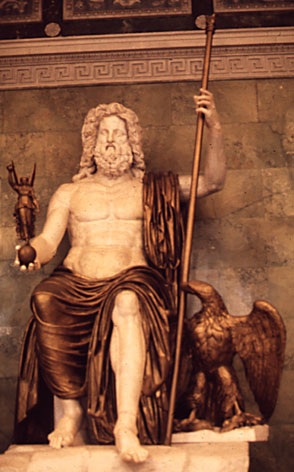
Louvre
One final image is this magnificent painting by Jean-Auguste Dominique Ingres (1780-1867), also appearing in the Introduction as a good example of the Neo-Classical style. Ingres certainly captures a feeling similar to the works of Classical times. In the painting below, the Nereid named Thetis begs a favor from Zeus, from a scene found in Book 1 of Homer's Iliad. The topic is detailed in Trojan War 1.
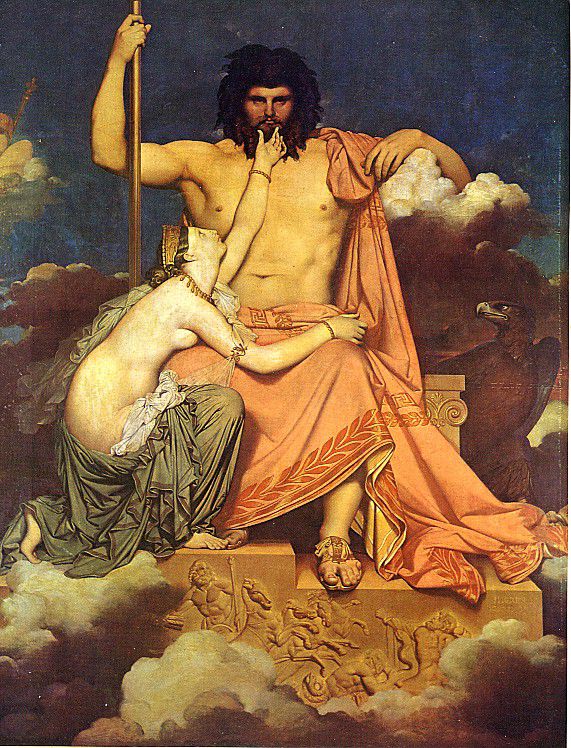
Jupiter and Thetis - Ingres (1811)
Besides his role as the ruler of the gods, one of the main characteristics of Zeus is his amorous nature; time and time again we find stories of his mating with females, both goddesses and mortals. Indeed, he is the father of more other gods, goddesses and heroes, several of whom will be viewed later, than any other deity.
However, there was at least one relationship unlike the majority of his affairs—his desire for a young man from Troy named Ganymede. This myth does indicate that Greek society had some tolerance of homosexuality, and usually in the sort of relationship seen here, an older man who pursues (or in Zeus' case, simply seizes) a younger man to whom he is attracted.
The first view is a red-figure vase painting with Ganymede in his role as Zeus' cup-bearer. Around them are several other Olympians: Hestia and Aphrodite on the right, Athena and a male on the left.
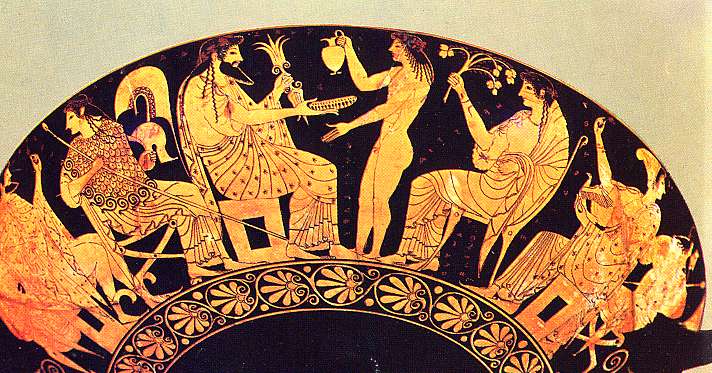
Red Figure
The next image of this pair is a terra cotta sculpture which is believed to have been an acroterion (a roof ornament, either at the central peak or corner of a temple roof) which was discovered in modern times at Olympia, and is now on display at the Olympia Museum. The date of 470 B.C. is an approximation based on comparison to other datable works from the Classical period. It is not known which building it originally stood on.

Olympia
The second view, a close-up, shows Zeus with just the hint of a smile as he rushes off with his 'prize.' Ganymede, on the other hand, is quite passive as he is carried off to Olympus. He is wearing a hat which was a way of identifying him as a Trojan. Also, he carries a rooster, a common gift given by an older man who sought to win over a younger man.

Olympia - Detail
The following two images are both from the Renaissance, first a painting by Antonio Allegri da Correggio (1489-1534), and then a bronze sculpture by Benvenuto Cellini (1500-1571) (whose bronze statue of Perseus, one of the greatest Renaissance sculptures, may be viewed in The Underworld). In both of these versions it is the eagle of Zeus (or perhaps Zeus himself in the form of an eagle) who is carrying off the young man.

Ganymede - Correggio (1531)

Ganymede - Cellini (1547)
As we just mentioned, Zeus was the father of numerous offspring, including some important minor goddesses, such as the Fates and the Muses.
From his union with Themis the Titan, Zeus became the father of the Moerae or, in English, the Fates, although some sources say the Fates are the children of Night. Hesiod alludes to both versions in the Theogony. These three females control the destiny of every individual, having power even superior to Zeus. In other words, not even Zeus can alter one's prearranged destiny.
The Fates' function was symbolized by the act of spinning wool into thread. Thus, their names are Klotho (the Spinner), Lachesis (the Measurer), and Atropos, literally "the Unturning One", because of her inflexible decision for where to cut the thread of life.
We see them first in a painting by Bernardo Strozzi (1581-1644), a follower of Rubens at the beginning of the Baroque style.

The Three Fates - Bernardo Strozzi
A Pre-Raphaelite version from 1885 by John Strudwick (1849-1937) entitled "The Golden Thread," with a close-up of the lower portion depicting the three Fates.
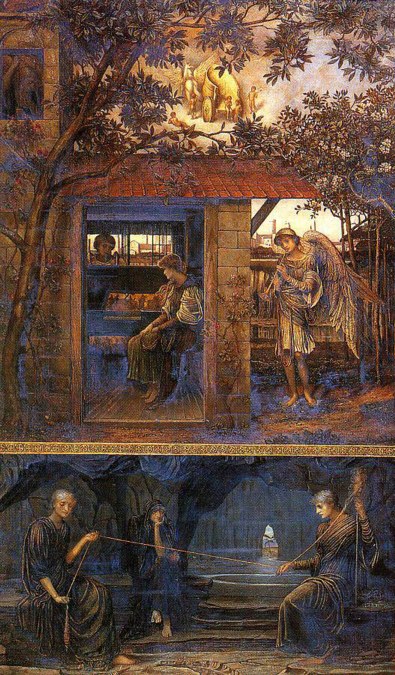
John Strudwick (1885)
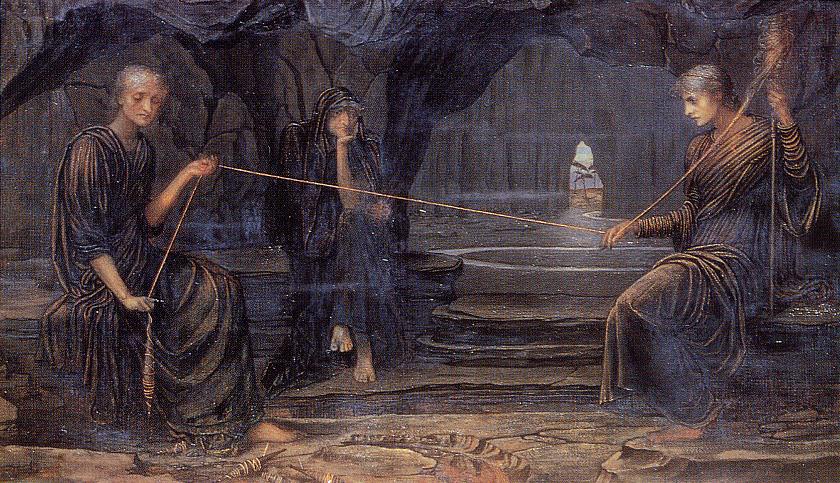
Strudwick - Detail
Zeus also mated with another female Titan, Mnemosyne (whose name means 'memory'), and from this union were born the nine Muses, the goddesses who inspire all forms of art and creativity. The poet Hesiod opens his poem Theogony with a salutation to the Muses, who he says appeared to him and filled him with his poetry.
The idea persists to this day, if not taken literally, that an artist has "really found her Muse," meaning that she is producing easily and quickly. Conversely, when an artist falls into a rut and no longer produces or takes longer and longer to create, he has "lost his Muse."
The nine Muses are depicted here in a Roman mosaic, all individualized, for each Muse had a specific area of creativity. For example, one was the Muse of dance, one was the Muse of drama, etc.

Roman Mosaic
Next is a painting by Andrea Mantegna (1431-1506), a major artist of the Renaissance. The title of the painting is Mount Parnassus, a location said to be special to the Muses. We see them in the lower center, dancing in a circle, while a male figure on the left (perhaps the god Apollo or possibly Orpheus) plays the lyre. This painting appears also in Aphrodite, where we have another look at Aphrodite and the other characters featured here.

Mount Parnassos - Andrea Mantegna (1497)
Finally is the version by Raphael, also entitled Mount Parnassus with a similar scene, located in the "Raphael Room" of the Vatican Museum. The lyre-playing figure in the center is surrounded by the nine Muses, while those further out to the sides represent some of the greatest artists and poets of history, such as Homer and Dante.

The Parnassus - Raphael (1509-11)
Zeus took as his wife his sister Hera, and the two ruled the other gods as the king and queen of the Olympians. Hera's primary role in mythology is her realtionship with Zeus. She is sometimes defined as the goddess of marriage, wives, and motherhood. Zeus and Hera did produce children together, such as Ares the war god and Hebe the goddess of youth, but as we have already learned, Zeus was notorious for his extramarital affairs with other goddeses, mortal women, and at least one male, Ganymede. Thus in many of the stories Hera has the role of the jealous wife, taking out her anger against her husband's lover or in some cases, the offspring.
But despite his numerous affairs, there was always a true passion between these two. Homer's Iliad contains a vivid poetical description of their lovemaking, with flowers blooming around their bodies as they lie together.
The first image here shows the couple in a work now at the Borghese gallery by Anibale Carracci (1560-1609).
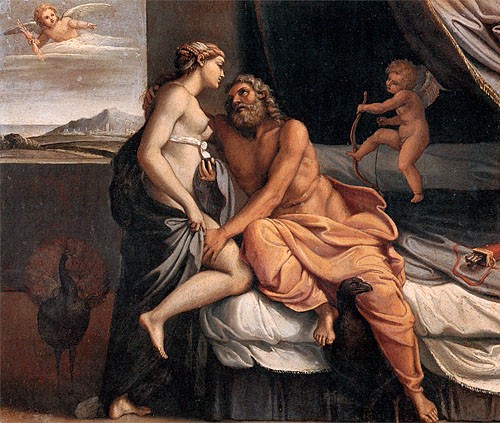
Jupiter and Juno - Carracci (1597)
A version by James Barry (1795-1865), a British painter active in the late 1700s.
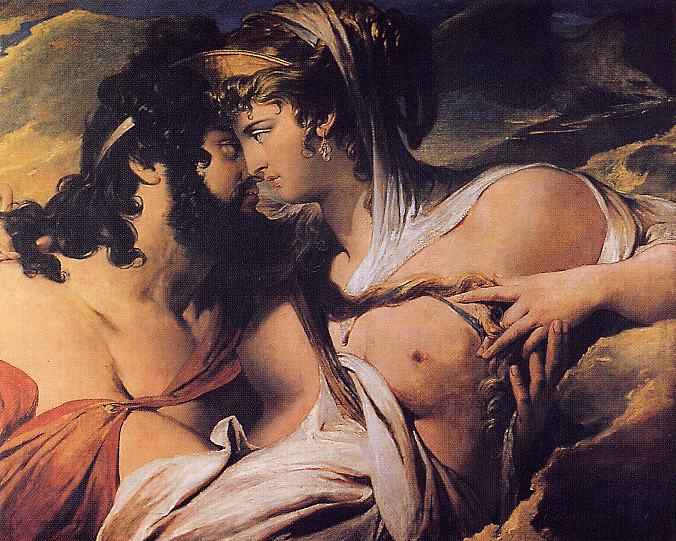
Jupiter and Juno on Mount Ida - James Barry (1790-99)
And finally one depiction of Hera (Juno) by herself in a watercolor by Gustave Moreau, who included one of Hera's traditional symbols, the peacock.
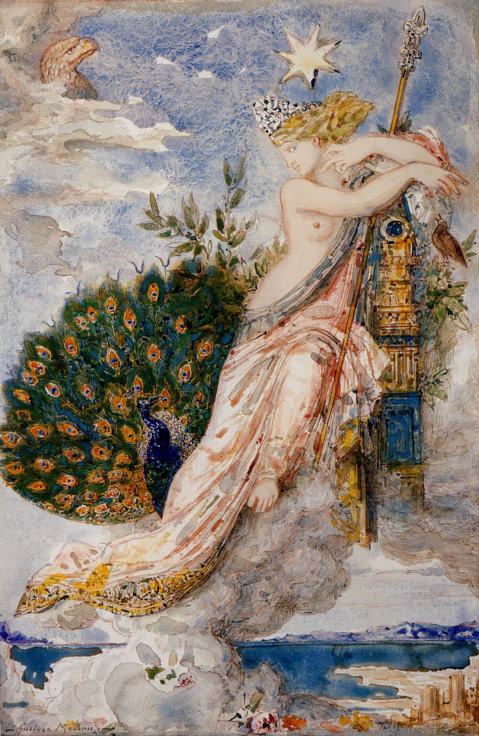
The Peacock Complaining to Juno - Gustave Moreau (1881)
We have just looked at several examples of art depicting the supreme god Zeus, and the next god to be discussed is Zeus' brother Poseidon, the main god of the sea. But before we look at him, there is an important bronze sculpture from the Classical period (on the basis of comparison with other works, an approximate date of 450 B.C. is assigned to it) which may be Zeus or may be Poseidon. Without any specific identifying symbols, these two gods can resemble each other quite a bit.
This majestic figure (6 feet, 10 inches tall) was discovered in 1926 off the coast of the Greek island Euboea, at a place called Cape Artemisium, which provided the name used today, the "God of Artemisium".

Artemisium 1
It is one of the finest discoveries of its kind, artifacts recovered from the remains of ancient sunken ships. In later times, when Greece had been conquered by other powers such as the Romans, the conquerors would often transport some of the best artworks elsewhere, but some of those ships sank, and their cargo remained at the bottom of the Mediterranean until the 20th Century. It is now in the National Museum, Athens.

Artemisium 2
The biggest mystery regarding this sculpture is which god it represents. The tell-tale clue would be the object he is about to throw from his right hand, an attached piece now missing. There are two primary possibilities: a thunderbolt or a trident. By comparing it with other representations as seen below, a case can be made for either possibility. But look at how Poseidon's trident on the coin passes behind the figure's head, something that would not be feasible in a three-dimensional work. So the current consensus now seems to favor the opinion that he held a smaller object, the thunderbolt of Zeus.

Figure & Coin
As the god of the sea, Poseidon (or Neptune) was definitely an important deity, but was never a truly major character in the myths and stories. He does feature in several important ones, but not as prominently as his big brother Zeus.
One in which he gets top billing is the contest of Poseidon and Athena. After a new city had been founded in the region of Attica, both of these deities wanted to be the city's main god, and it was agreed that whichever of the two gave the people the best gift would be the winner. Poseidon thrust his trident (three-pronged spear) into the ground, and a stream of water flowed out. Athena magically created the first olive tree, which was judged the best offering, since the production of olive oil would bring long-term prosperity. The new city was named Athens in honor of the victorious goddess, today's capital of modern Greece.
The first image below is a black-figure vase painting of these two gods, which is signed by its artist. But often there was one artist who shaped the clay, and a second artist who did the decoration/painting. This vessel has the sentence "Amasis made me" running down the center. The term "made" usually indicates the potter, not the painter, so it is uncertain if Amasis is the name of only the potter or both. To be safe, we call the artist the "Amasis Painter". The Adonis article contains a look at the other side of this vessel, which features the god Dionysus.

Amasis Painter
The second image is a version of the contest between Athena and Poseidon as it appeared on the pediment of the Parthenon, the largest temple of ancient Athens, and a subject covered in the article on Athena. The original sculptures from this pediment are either missing or badly damaged. To get a sense of what it actually looked like, we have a 20th Century reproduction in the Parthenon located in Nashville, Tennessee.
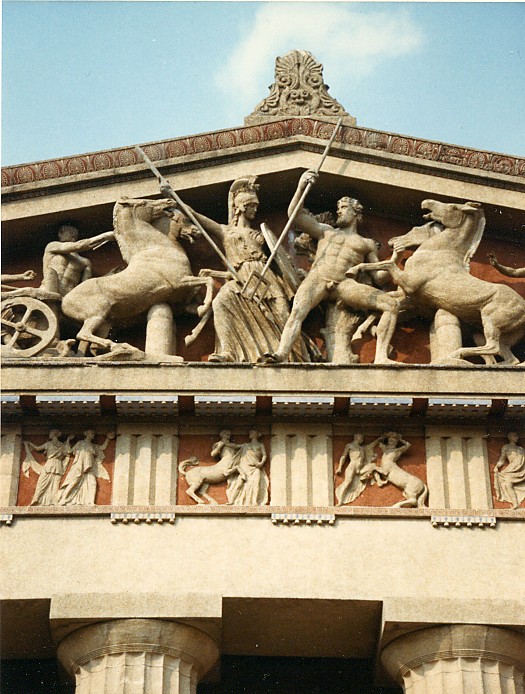
Parthenon Pediment, Nashville
Next is a typical Hellenistic statue of the god from the island of Melos. Not particularly unique or unusual, it is basically a standard statue of a god.
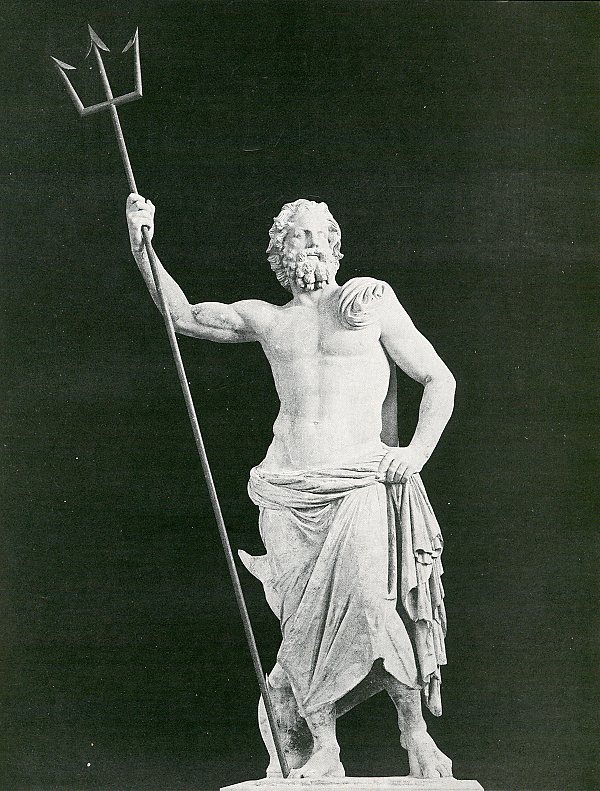
Melos
The next image is a mosaic of the sea-god in his chariot (drawn by sea-horses, of course) found in a Roman-period house in modern-day Tunisia.

Mosaic
Gian Lorenzo Bernini included Triton, the son of the sea god, seen under the main figure's legs in this sculpture.
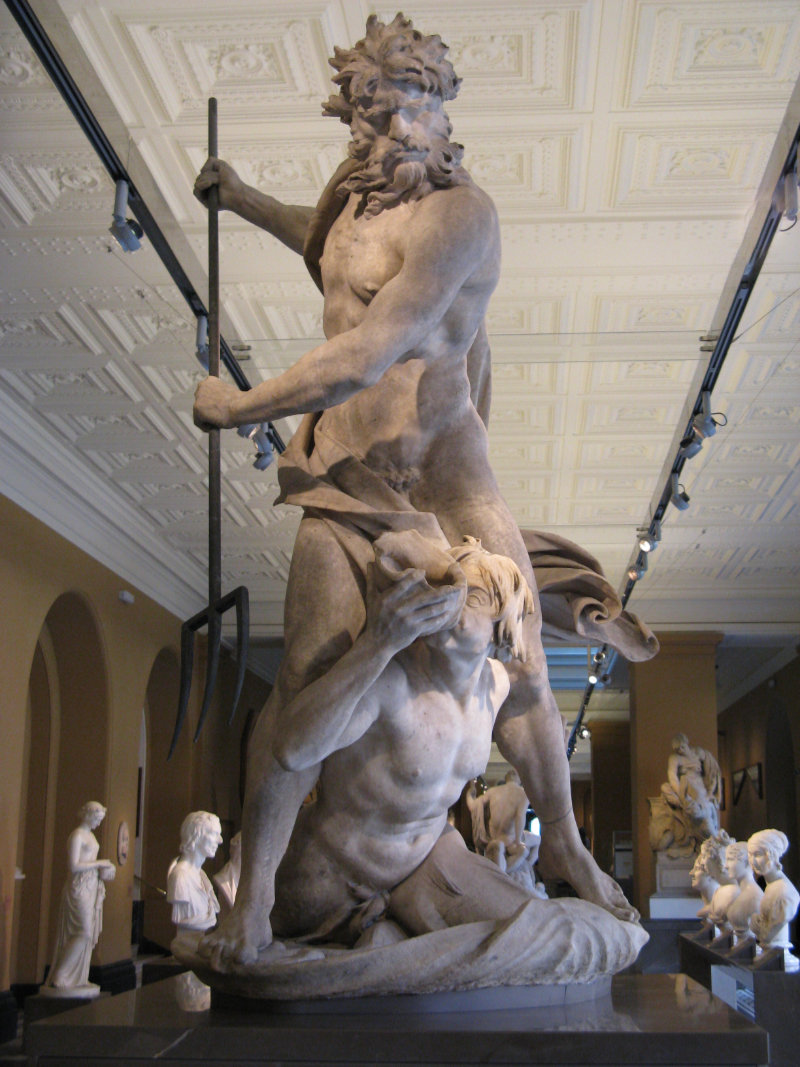
Neptune and Triton - Bernini (1623)
The painting by Nicolas Poussin (1594-1665) seen below has long been known as "The Triumph of Neptune and Amphitrite", (the goddess bride of Poseidon). Closer scrutiny, however, might indicate that the subject is yet another version of the birth of Aphrodite—note the dove-drawn chariot arriving in the left rear, a vehicle associated with that goddess in myth.
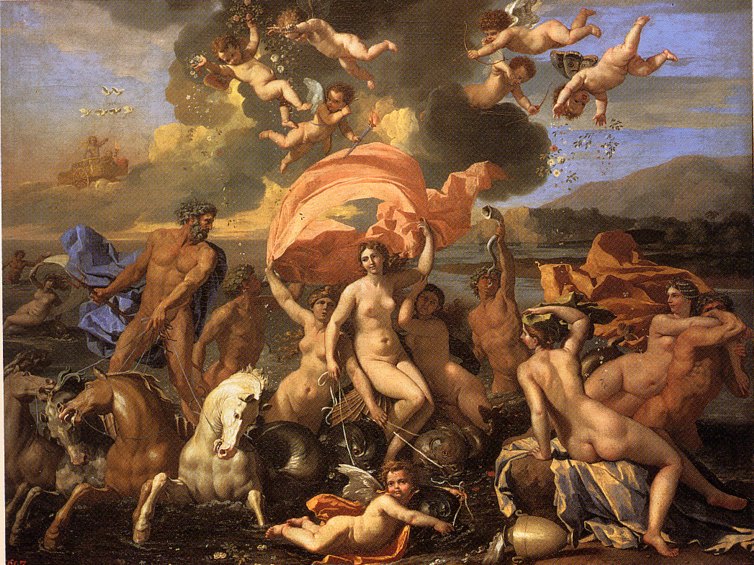
The Triumph of Neptune and Amphitrite - Poussin (1637)
Finally, a painting by 19th Century Swiss artist Arnold Böcklin, showing not Poseidon himself, but a pair of his associates, a Triton and a Nereid, mythical creatures now generally referred to as mermen and mermaids.
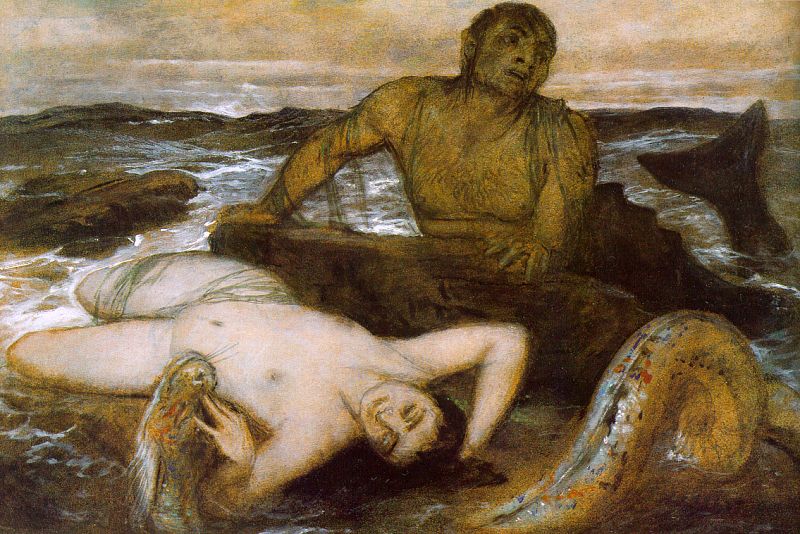
Triton und Nereïde - Böcklin (1877)